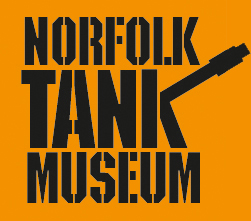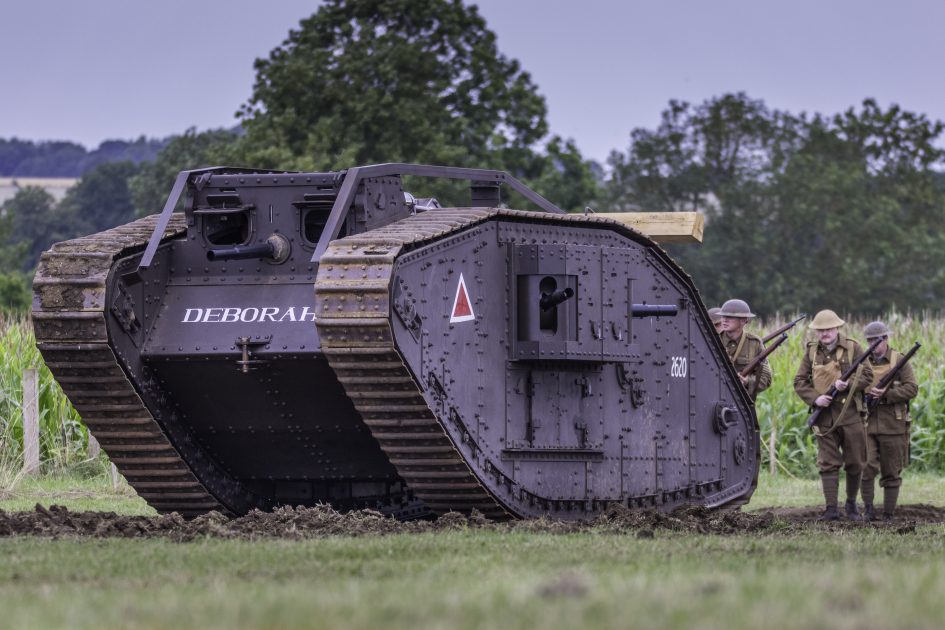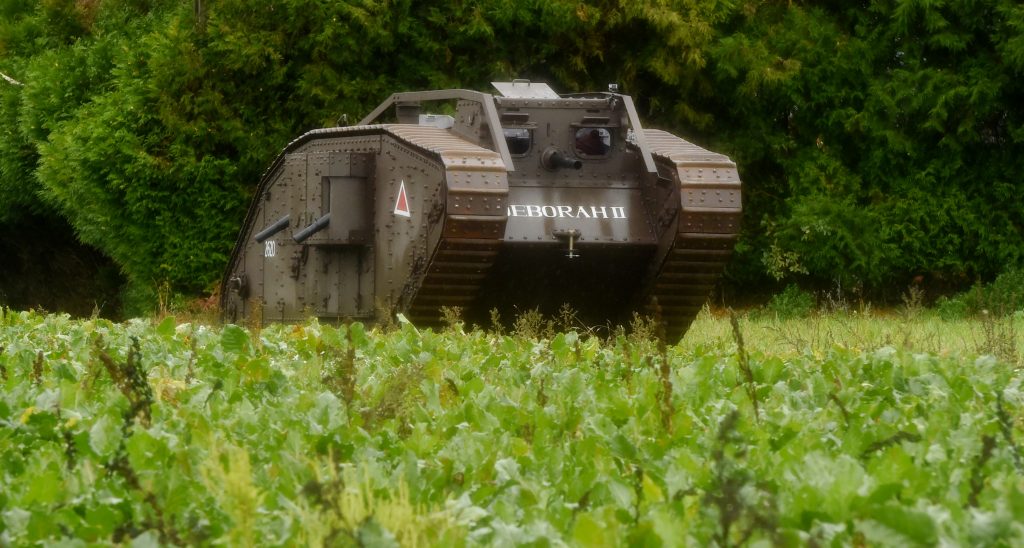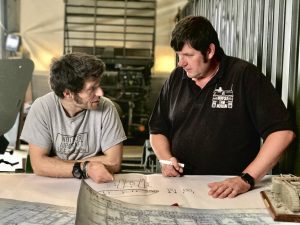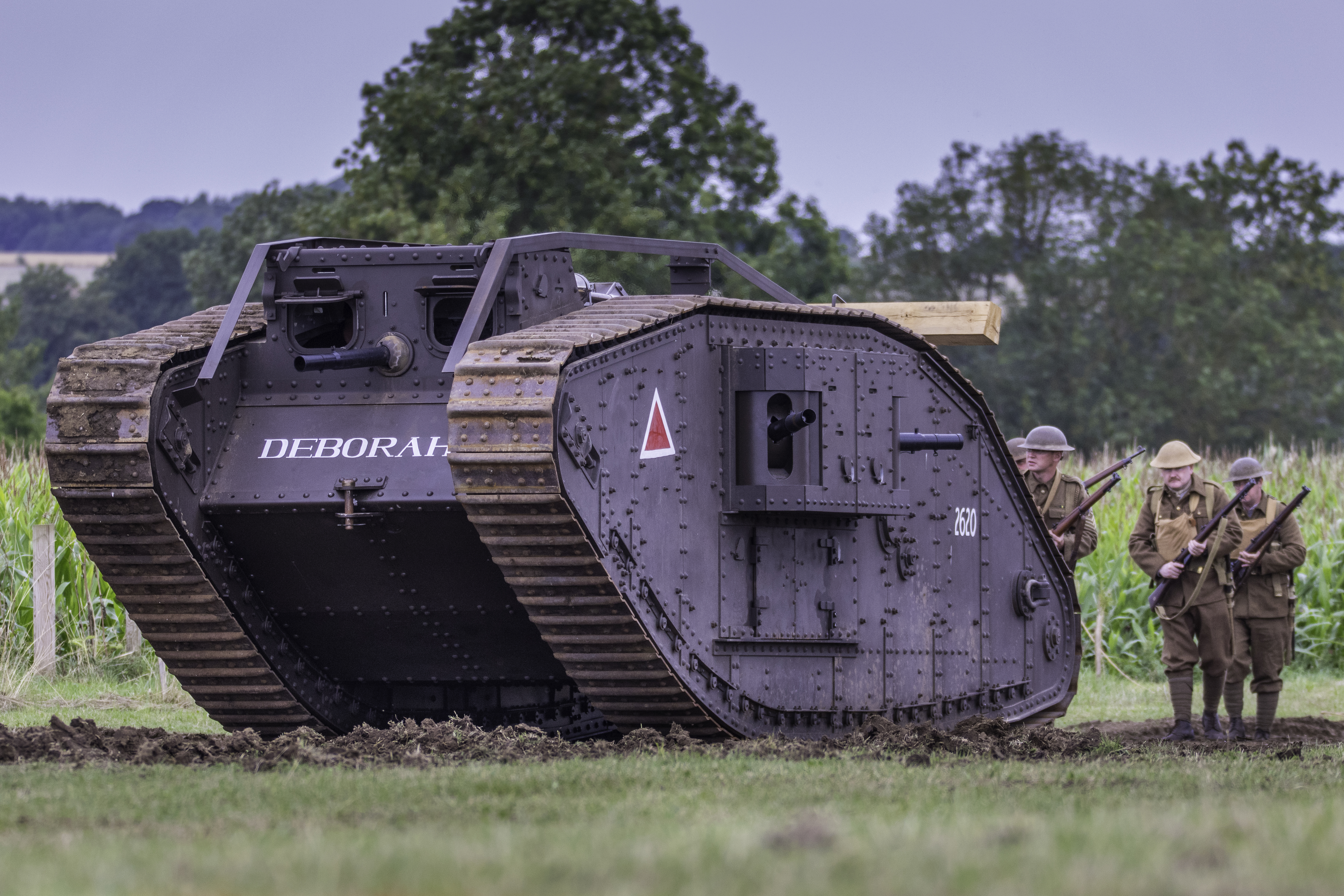Mk IV Tank – Deborah II
Deborah II at the Norfolk Tank Museum is a reproduction of the original Mk IV tank Deborah which was knocked out of action at The Battle of Cambrai on 20th November 1917. Deborah was a Mark IV Female of 12 Section, 12th Company, D Battalion. Deborah was in the second wave of the attack, tasked with attacking the Hindenburg Support line west of Flesquieres, Commanded by 2/Lt Frank Heap, she entered the village firing into the ruins to suppress the defenders. As she left the shelter of the village she was hit by several enemy artillery rounds and five of her eight crew were killed. 2/Lt Frank Heap and the two remaining crew members were able to retire back to British lines, he was subsequently awarded the Military Cross for his gallant actions
The Mk IV was the third production tank in a series of WW1 tanks. It was introduced in May 1917 after slight changes to the earlier Marks. Prior to the Mk IV attrition rates had been enormous, the Mk I had proved to be far from perfect on the battlefield. The first tanks were originally developed after intense trialing of different designs throughout 1915 and early 1916. The rhomboid design with the high climbing face of the track was designed to cross the wide and deep trenches prevalent on the battlefields of the Western Front. Given the tank’s hull length of 26 ft 5 inches and the height necessary for the shape, an armed turret would have made the vehicle too tall and unstable. Instead, the main armament was arranged in sponsons at the sides of the vehicle. The Mk I was fitted with additional trailing wheels as an aid for steering, but were omitted on the Mk II as they found to make no significant difference and were actually a hinderance. The Mk II and III, both training machines, featured many modifications to the original Mk I, these modification culminated with the production of the Mk IV. The most significant changes being: an increase in armour thickness, moving of the fuel tank to the rear and a major redesign of the sponsons for ease of transportation; the sponsons were now able to be pushed inwards into the hull instead of being removed.
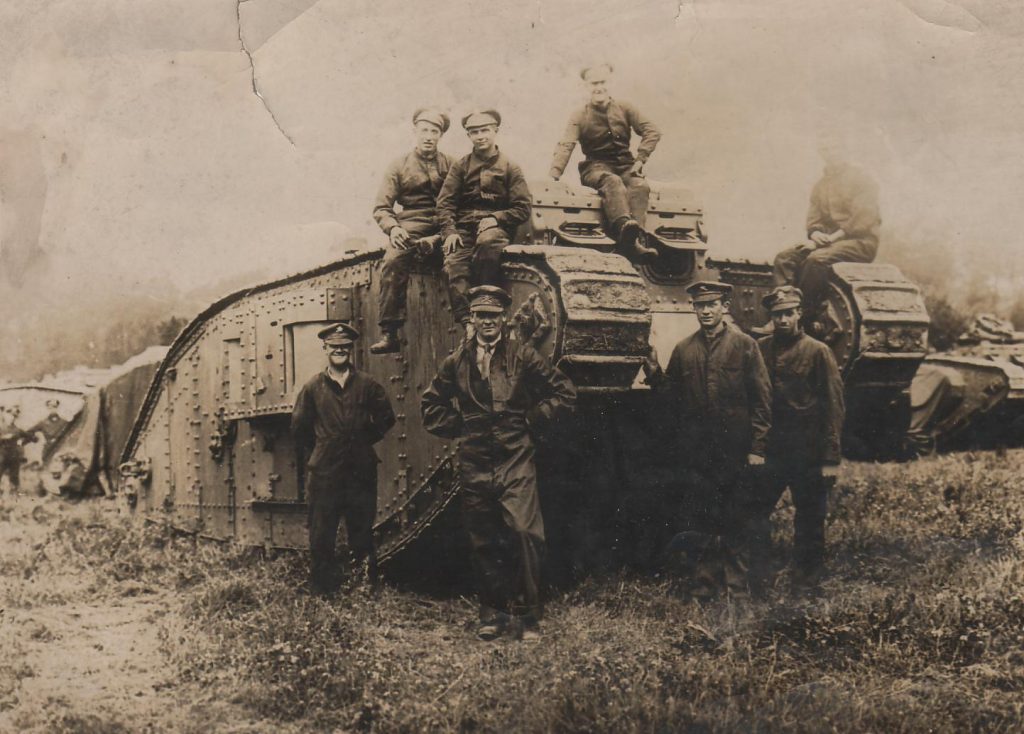 Originally there were plans to introduce a new engine for the Mk IV, but a failure to develop it in time to start production of 200 tanks ready for the promised date of 1 April 1917, meant this did not happen.
Originally there were plans to introduce a new engine for the Mk IV, but a failure to develop it in time to start production of 200 tanks ready for the promised date of 1 April 1917, meant this did not happen.
The Mk IV went into production in May 1917 using the original 105HP Daimler in line, double sleeve valve, 6 cylinder, 13 litre water-cooled engine. This gave the vehicle a power to weight ration of 3.75 HP per ton and a top speed of 4MPH. The male tank was fitted with 2 Quick Fire 6pdr (57 mm) guns which were now short-barrel as compared to the previous Marks, and three compact, light and reliable Lewis machine guns which were favoured over the early Hotchkiss. The earlier Hotchkiss had been sturdier and more affordable, but was criticised for its lack of magazine capacity, 14 rounds compared to 96 for the Lewis. The female tank was fitted with five Lewis machine guns.
Another improvement to the Mk IV was the carrying of an un-ditching beam, often made from oak and reinforced with sheet metal, which was stored at the rear of the tank, and also the fitting of two parallel rails running the entire length of the roof which enabled the deployment of the beam. The beam could be deployed by attaching its chains to the tracks, the tracks would then drag the beam over and then under the tank enabling the tank to pull itself out of boggy ground.
Conditions inside the tanks were certainly not crew-friendly, the smell, heat and fumes from the exhaust and the cordite from the guns firing would have made the early WW1 tanks no nice place to be. Rather than being in a separate compartment the engine was mid-mounted, meaning there was no separation between it and the crew. The men suffered from carbon monoxide poisoning from leaking exhaust fumes, heat exhaustion – there are reports of internal temperatures reaching an unbearable 50 °C (122 °F), and of course the noise itself from the massive engine resonating inside what is, ostensibly, a steel box. The only way the crew could communicate was to use hand signals.
Driving the vehicle was no simple task. Two drivers are positioned at the front of the vehicle, one in charge of the steering brakes the “Driver” and the “Commander” who was responsible for the clutch, brake and gear change controls – two forward and one reverse. There were also two “gears men”, one on either track, they were able to alter the track speeds selecting high, low or neutral. To make a turn the Commander had to bring the vehicle to a halt, one of the gears man would then engage ‘low’ on his side leaving the other gears men in ‘high’, this gave the tank a large turning circumference. Alternatively, putting one track in ‘low’ and the other in ‘neutral’ with the driver applying the correct steering brake lever, and not forgetting to also engage diff-lock, one could carry out a skid turn by locking one track. If diff-lock was forgotten the tank would not move at all. This was complicated teamwork made all the more intense when under enemy fire.
Communication with other tanks and HQ was achieved through different coloured flares or carrier pigeons. The crew were issued with the 0.455 Webley revolver in case they had to abandon the vehicle. Crew safety was an issue inside the tank, with each bullet impact on the tank mini-shrapnel or spall, which could be as small as a millimeter square, was produced inside the hull injuring the men inside. Following the first reports of spall thick leather jackets and helmets, or a combination of leather and chain-mail, were provided to the crews. Foam liners or padding inside the tanks to stop spall only appeared decades later.
SPECIFICATION
- Weight: 28 tons
- Width: 11ft 8in.
- Height: 8ft.
- Length: 26 ft 5 in
- Max Speed: 4 mph
- Power/weight 3.75 hp/tonne
- Suspension None
- Range: 35 miles
Crew of Eight: Driver, Commander, Two gears man, Four Gunner’s
Inspiration
The inspiration for the documentary was to try and recreate a replica Mk IV Tank, the first tank to see successful active duty in the Battle of Cambrai. The Battle took place in Northern France on the 20th November 1917; 100 years ago. The British Army amassed 475 tanks to attack the German Hindenburg Line, a huge feat of engineering at the time. We decided to build the tank as close to the original as we possible could, using the modern technology available. We wanted to recreate the original sounds and smells to get a real feel for the enclosed space within the tank, so a petrol engine and a mechanical gearbox with chains to the final drives was selected. We knew that given this mechanical and true-to-the-original setup, we would need three people to drive it: a commander who controls the clutch, brake and accelerator; a driver who steers the vehicle; and a gears-man.
The Build
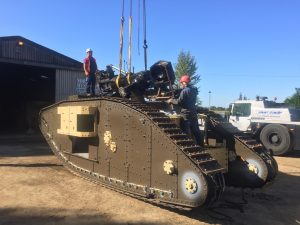 To achieve a replica of this magnitude NorthOne TV, with Project Manager Stephen MacHaye, approached JCB to fabricate the hull. To demonstrate modern technology it was decided that state of the art computerised welding techniques would be used, and the rivets of the original design, although not practical to replicate, would be welded in place to give the effect of the 1917 build.
To achieve a replica of this magnitude NorthOne TV, with Project Manager Stephen MacHaye, approached JCB to fabricate the hull. To demonstrate modern technology it was decided that state of the art computerised welding techniques would be used, and the rivets of the original design, although not practical to replicate, would be welded in place to give the effect of the 1917 build.
Chasestead World Class joined the team and fabricated the tracks from steel plate, 90 each side as per the original, along with many other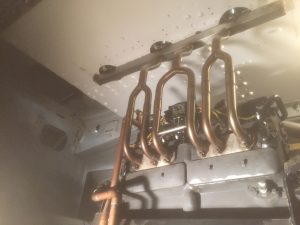 smaller components including the drivers’ hatches and pistol ports. RH Barrel made the Lewis Machine Gun mounts and the driver controls. The volunteers at the Norfolk Tank Museum constructed the engine and transmission, utilising a Rolls Royce B60 engine connected to an agricultural transmission, an engineering jigsaw puzzle which used all the ingenuity of the museum team. On top of this they assembled a multitude of components including the tracks, sponsons and detailing, including painting, to finally bring the Mk IV to life.
smaller components including the drivers’ hatches and pistol ports. RH Barrel made the Lewis Machine Gun mounts and the driver controls. The volunteers at the Norfolk Tank Museum constructed the engine and transmission, utilising a Rolls Royce B60 engine connected to an agricultural transmission, an engineering jigsaw puzzle which used all the ingenuity of the museum team. On top of this they assembled a multitude of components including the tracks, sponsons and detailing, including painting, to finally bring the Mk IV to life.
The C4 Documentary, ‘Guy Martin’s WWI Tank’.
Pre-production talks between NorthOne TV, the Norfolk Tank Museum, JCB and Chasestead World Class began in May 2017. With the date of the 11th November set to celebrate 100 years from the first successful use of the tank, we had very little time to make it. The tank was finally completed on 9th November, just six months later.
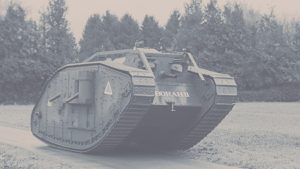 Guy Martin was to be the presenter of the documentary, with a personal interest in the tank and its construction due to his engineering background. Guy spent several days filming at JCB, Chasestead and the Museum. With the tank complete and the deadline for the commemoration of the Battle of Cambrai looming, preparations were made to take the tank to France.
Guy Martin was to be the presenter of the documentary, with a personal interest in the tank and its construction due to his engineering background. Guy spent several days filming at JCB, Chasestead and the Museum. With the tank complete and the deadline for the commemoration of the Battle of Cambrai looming, preparations were made to take the tank to France.
On a cold, wet and windy day in November the tank paid a fitting tribute to the brave men of the British Army that lost their lives fighting for freedom from tyranny, a sight that Guy and everyone involved in the build was able to witness. It has been a project that all of us are very proud of.
